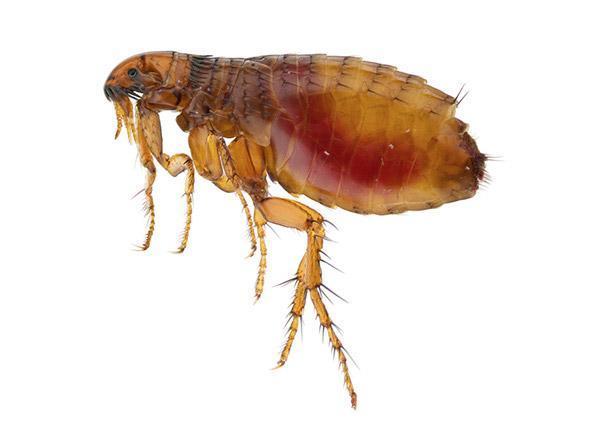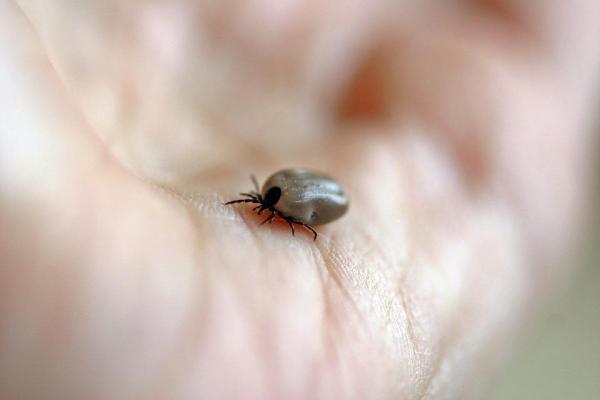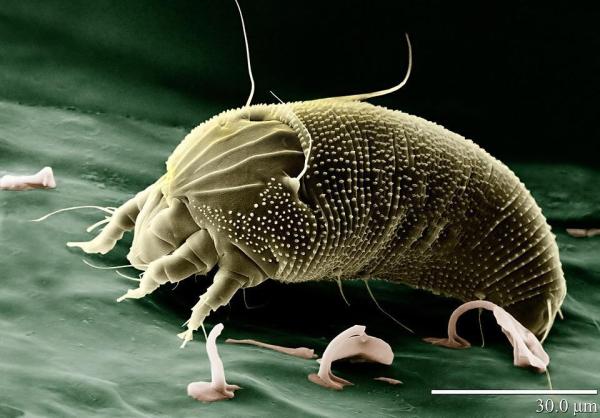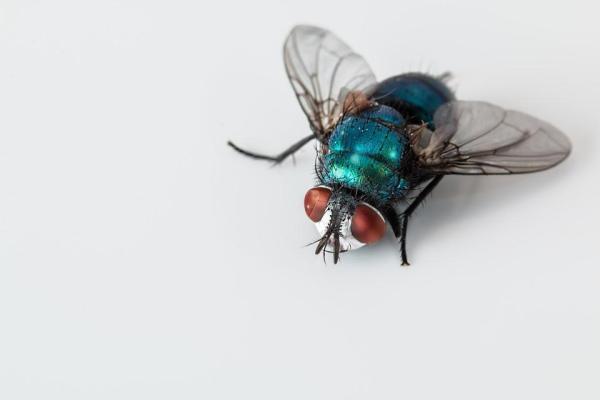
When the seasons change and the year starts to warm up, there are a lot of advantages for a cat. Although warmer weather means they can enjoy the outdoors more, it can bring other challenges. External parasites are one of the most problematic issues which can affect a cat's well-being. Not only can they provide superficial problems in the form of hair loss and itching, but they can spread life threatening diseases.
At AnimalWised, we look at the most common external parasites in cats, so you know what might be bothering your feline. We also explain the best ways to prevent them affecting your cat.
What are external parasites in cats?
A parasite is an organism which survives at the expense of another, feeding on their host without killing them directly. Parasites come in many different forms, but the CDC (Center for Disease Control and Protection) categorizes them into three main groups:
- Protozoa: microscopic single-cell organisms which can live in the gastrointestinal system, but can also live in the tissue of the animal. Some protozoa are so small, they are intracellular. This means they live within the cells of said tissues. Some may not have any effect on the host, others cause serious disease.
- Helminths: larger multicellular organisms which are considered types of worm. They often affect the gastrointestinal system, but can live in other tissues of the body such as the eye, heart or lungs.
- Ectoparasites: this is a large umbrella term for parasites which feed off the host externally, as opposed to endoparasites which do so internally.
In even more general terms, there are two main categories of parasite: internal parasites (endoparasites) and external parasites (ectoparasites). The most common types of external parasites in cats are:
- Fleas
- Lice
- Ticks
- Mites
- Screwworms
- Fungi
The presence of external parasites in cats can lead to various symptoms, often related to their physical presence. These include itching, inflammation, hair loss and pruritus. External parasites are not in themselves fatal to the cat, but their presence can be. This is because they can transfer bacteria, viruses and even internal parasites which cause parasitosis, i.e. diseases stemming from parasitical infestation.
In most cases, external parasites in cats are not difficult to eradicate. With a visit to the veterinarian, the parasites can be removed with treatment and prevented from returning thanks to deworming treatment. We explain further in the sections below.
1. Fleas
Fleas are the most common ectoparasite in cats, especially those of the species Ctenocephalides felis. These fleas are named after their main host, but they can also affect dogs, something which doesn't happen with every flea species.
The adult flea can be seen with the naked eye and often causes itching for the cat. More concerning are the larvae, pupae and eggs which can be spread. They fall off the coat of the cat and nest in carpets, on furniture or any place which is hospitable to them.
The lifecycle of the cat flea depends on the environment and temperature. It can last from several weeks to several months. Once detached from the host, adult fleas will not last longer than 1 - 2 weeks. Cat flea larva can hibernate and wait for months until the right conditions allow them to develop into adult fleas.
In addition to causing the cat to scratch themselves, fleas can cause skin damage, hair loss and poor coat condition. These are a consequence of how the flea feeds off the cat. They break the skin to suck out the feline blood, a process which can generate several health problems:
- A flea bite can cause allergic dermatitis in the cat, resulting in enormous pain and itching. In an effort to relieve this pain, the cat often scratches and may cut themselves in the process. Secondary infections can result if wounds are not clean.
- Fleas can transmit bacteria that contain endemic typhus.
- Fleas can transmit internal parasites, such as flatworms or tapeworms.
- Loss of blood causes weakness and increases the risk of anemia. This can reduce their energy levels even further and provide other secondary complications.
Removing fleas from cats is not particularly difficult. You will simply have to apply the treatment recommended by the veterinarian. This usually consists of bathing them with a medicated shampoo. Deworming products will need to be administered regularly after the initial infestation has gone. We also need to thoroughly clean the environment in which the cat was infested as flea larvae might still be present.

Lice
Lice are very common parasites in humans, but they can also present in cats. There are at least 50 types of lice which can affect felines, but one of the most common are Felicola subrostratus, also known as the cat-biting louse. It is important to note that the presence of lice in domestic cats is relatively unusual. They only usually affect felines that are immunosuppressed or in poor hygienic condition.
The cat louse is not very contagious (it does not survive more than 1 or 2 days outside the host) and does not represent a danger to humans. Infestations are most common from outdoor sources, meaning indoor cats suffer from lice even less.
We can detect the presence of lice by the appearance of whitish eggs which are firmly attached to the animal's fur. They can be removed with a special lice or flea comb. A lice infestation can result in:
- Itching, eczema, seborrhea and hair loss.
- Pediculosis, a skin condition which only occurs when there is a large infestation.
- Wounds with pustules that can cause a secondary infection.
- Transmission of intestinal parasites, such as Diplidium tapeworms.

Ticks
Ticks are larger than most other external parasites in cats, but they similarly feed on the blood of their hosts. Their presence is particularly worrisome as their process of sucking blood can lead them to being vectors of various diseases. Some of these diseases are debilitating and, potentially, life threatening. There is a greater risk of contagion in hot weather.
The lifespan of a tick can vary and there are many factors which determine how long they will last. However, they can take up to 2 years to complete their lifecycle. Since ticks will not leave the host willingly, they rarely transfer from one cat to another. Most commonly they attach themselves when the cat is outside they walk past a plant where is waiting for a host.
Ticks are easy to spot with the naked eye, especially if they have been feeding. They can be more difficult to spot in long-haired cats, but most can be seen with the help of a flea comb. They most commonly attach themselves to the head and legs of the animal, often inserting themselves between the digits of their paws.
There are many diseases that a tick can transmit. The most common are:
- Bacterial infections from Ehrlichia spp, Anaplasma phagocytophilum and A. platys.
- Protozoan infections from Babesia spp.
- Lyme disease, caused by the bacterium Borrelia burdogferi.
- Anemia as a consequence of blood loss in large infestations.
- Body paralysis produced by the Dermacentor andersoni and Dermacentor variabilis ticks.
To eliminate ticks we recommend cleaning the tick first with alcohol or oil. This numbs the tick and makes them easier to remove, without damaging the cat's skin. We recommend using a specific tick removing tool, but we can use tweezers if they are now available. You need to twist the tick as your remove them.
If you are too abrupt and don't twist the tick, their jaws may be left embedded in the cat's skin. This can cause inflammation and increase risk of infection. After removing the tick, wash and disinfect the bite site.

Mites
Mites are a group of arachnid external parasites that spread different types of skin infestation known as scabies. The type of scabies will depend on the type of mite present. The mites nest in the lower layers of skin, digging furrows in which they are better able to reproduce.
In cats, mites mainly infest the legs, neck, head and ears. They presence results in wounds which cause the cats to scratch them and introduce secondary infections. Hair loss, inflammation and redness are produced, giving the scabies its signifying appearance.
Mange is the general word for skin diseases caused by mites. Scabies is a type of mange caused by specific mites. The two main types of mange are caused by:
- Otodectes: usually affects the ear and are considered ear mites. They can cause various ear problems, especially otitis.
- Sarcoptic mange: caused by a highly infectious mite which presents externally on the cat's skin. They cause intense itching and are particularly troubling for cats with suppressed immune systems. It is very contagious and a type of cat disease which can transfer to humans.
Although the contagion between animals of the same species is high, it only occurs with direct contact. If one of your cats has mange, then any others need to be checked and their toys, bed and accessories need cleaned immediately.

Screwworms
Screwworms are the larval stage of certain flies which are very dangerous to cats with open wounds. The flies deposit their eggs into the wound and the eggs develop into screwworms. They are responsible for a condition known as myiasis, a condition where the larvae develop inside the skin of the body.
In just a few days the eggs hatch into larvae and they start to eat the tissue of the cat and cause necrosis. This is why you might see maggots in a cat's wound. The infection spreads and can threaten their lives.

Fungi
We might not think of fungi as being a parasite, but there are some which act in a parasitical fashion on cats. One of the most common is known as ringworm, even though they are not a type of helminth. Ringworm causes a skin disease known as dermatophytosis that affects felines and is relatively easily recognized. It should be noted that it is transmissible to humans.
A cat that suffers from ringworm will present with areas on their coat where the fur falls off and skin is exposed. When the skin is visible, there appears a round red mark which is where ringworm derives their name. The skin can appear flaky and scabs appear on the skin. It most commonly affects cats which are very young, old or sick.
You cat may become infested if they have come in contact with another feline with ringworm or another fungus. However, they can get it from accessories shared by an infested animal or even if they are in dirty places where the fungus is dormant. This is another reason it is very important to maintain good hygiene in the home.

What to do if my cat has external parasites
We need to first understand that these external parasites on cats can be easily eliminated. There are products on the market which are available after only a brief consultation with your veterinarian. We should always go to a vet for a checkup first in case we misinterpret any of the symptoms.
We should never blame the cat for having external parasites as they are a common problem. Preventing and treating them are part of the responsibility cat guardians take on when they adopt a feline.
The veterinarian will recommend the right kind of anti-parasitic product depending on the type of parasite. With internal parasites in cats, it is common for a test to be carried out to determine the type of parasite. This is not usually the case with external parasites.
The cat may be given various types of treatments. Shampoos may be required to rid the animal of the infestation, but this will usually be followed with preventive medicine in the form of pipettes, flea collars or even antiparasitic sprays. The treatment will also depend on the extent of the infestation. Preventive medicine in the form of deworming and vaccination schedules are vital for a cat's health and well-being.
Since many external parasites can transfer to other parts of the home, all of the cat's accessories, toys, beds and any part of the home they spend any time will also need to be cleaned. If there are other pets in the home, they will need to be examined for the presence of external parasites and treated if necessary.
You can learn more about how to prevent external parasites in cats with our video below on what to expect from their first veterinary visit:

If you want to read similar articles to Most Common Types of External Parasites on Cats, we recommend you visit our Fur care category.
- CDC. (2020). About Parasites.
https://www.cdc.gov/parasites/about.html